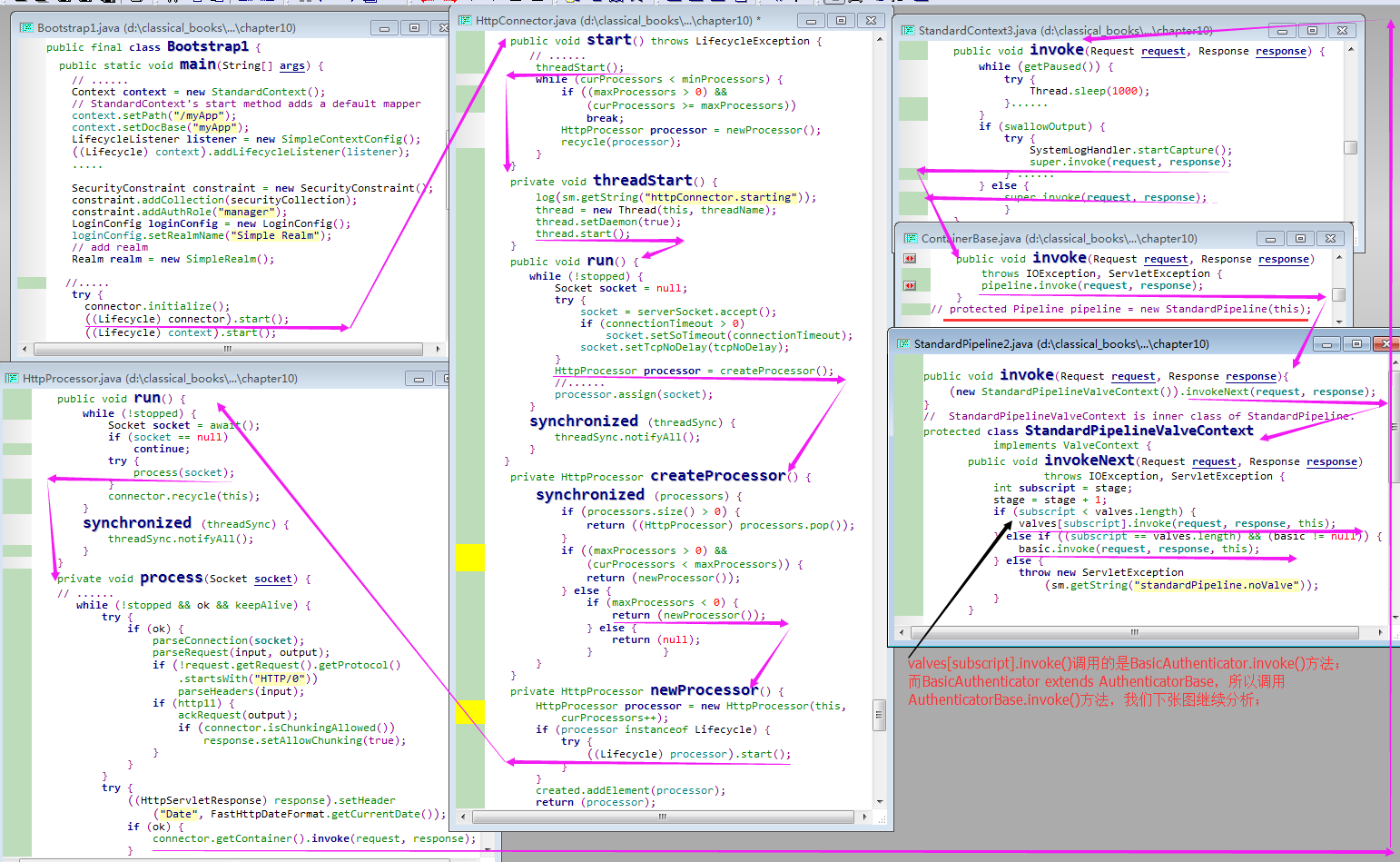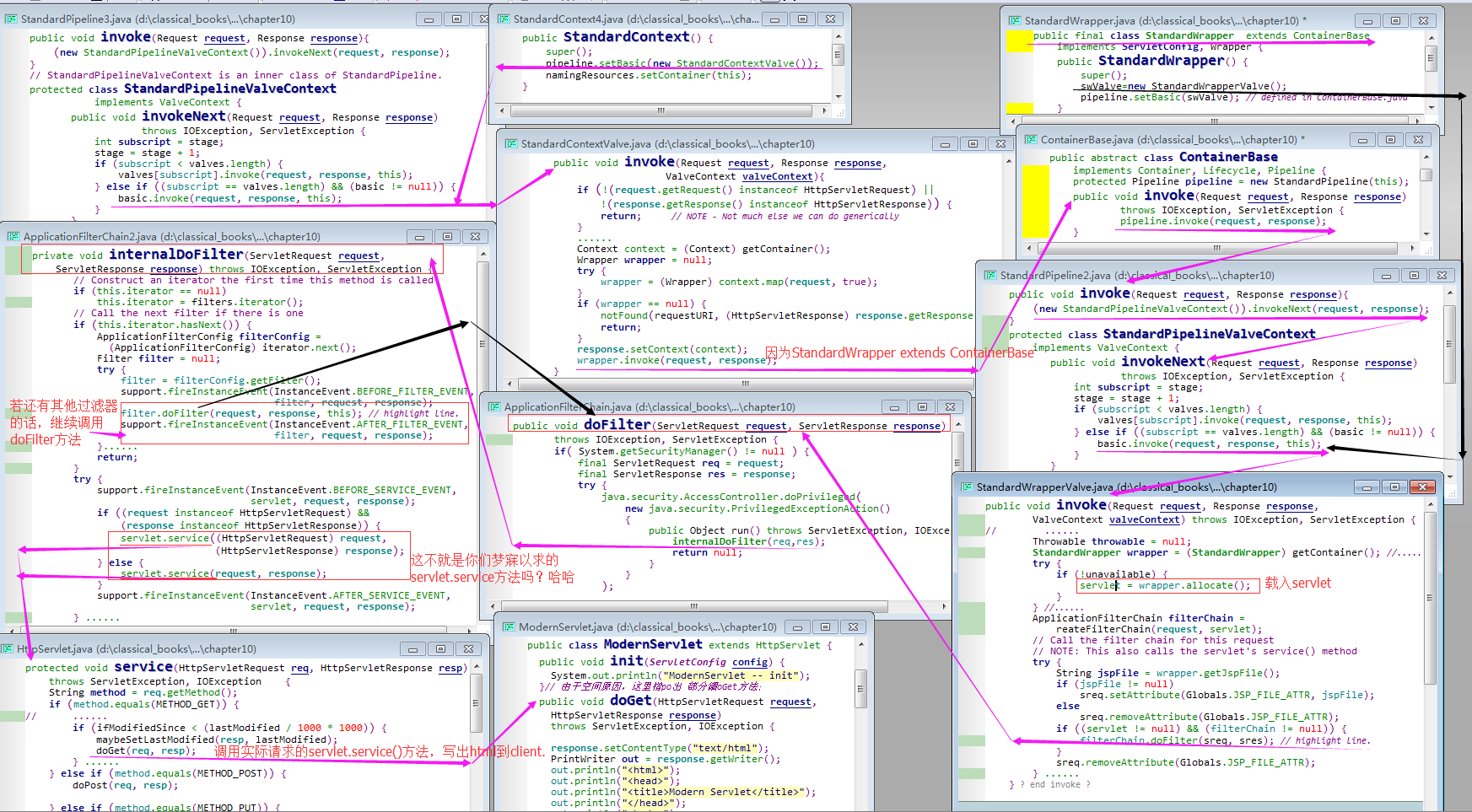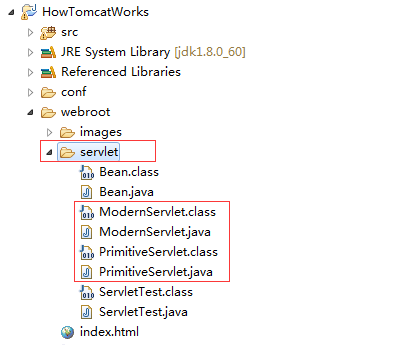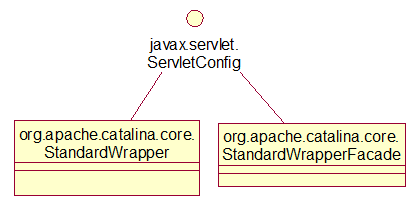【0】README
0.0)本文部分文字描述转自 “how tomcat works”,旨在学习 “tomcat(11)StandardWrapper源码剖析” 的基础知识;
0.1)StandardWrapper 是 Catalina中对Wrapper接口的标准实现;要知道,tomcat 中有4种类型的容器:Engine,Host,Context 和 Wrapper;(干货——review tomcat 中有4种类型的容器:Engine,Host,Context 和 Wrapper)
1)对于每个引入的http 请求,连接器都会调用与其关联的servlet容器的 invoke() 方法。然后,servlet容器会调用其所有子容器的invoke() 方法;
2)下图展示了连接器接收到http 请求后的方法调用的协作图;

3)上图的具体steps 如下:
step1)连接器创建 request 和 response对象;step2)连接器调用StandardContext.invoke()方法;step3)StandardContext.invoke()方法调用其管道的invoke() 方法。StandardContext的管道对象的基础阀是 StandardCoantextValve类的实例,因此, StandardContext 的管道会调用 StandardContextValve.invoke()方法;step4)StandardContextValve.invoke()方法 获取相应的Wrapper 实例处理 http请求,调用Wrapper实例的invoke()方法;step5)StandardWrapper类是Wrapper接口的标准实现,StandardWrapper.invoke()方法 会调用其管道对象的invoke()方法;step6)StandardWrapper的管道对象中的基础阀是 StandardWrapperValve 类的实例,因此,会调用StandardWrapperValve.invoke()方法,StandardWrapperValve.invoke()方法会调用Wrapper实例的 allocate() 方法获取servlet实例;step7)allocate()方法调用load() 方法载入相应的servlet类,若已经载入,则无需重复载入;step8)load()方法调用servlet实例的init()方法;step9)StandardWrapperValve调用servlet.service()方法;// Call the filter chain for this request// NOTE: This also calls the servlet's service() methodtry { // org.apache.catalina.core.StandardWrapperValve.invoke()String jspFile = wrapper.getJspFile();if (jspFile != null)sreq.setAttribute(Globals.JSP_FILE_ATTR, jspFile);elsesreq.removeAttribute(Globals.JSP_FILE_ATTR);if ((servlet != null) && (filterChain != null)) {filterChain.doFilter(sreq, sres); // highlight line. doFilter() calls servlet.service()}sreq.removeAttribute(Globals.JSP_FILE_ATTR);}
Attention)StandardContext类的构造函数会设置StandardContextValve类的一个实例作为其基础阀;
public StandardContext() { // org.apache.catalina.core.StardardContextsuper();pipeline.setBasic(new StandardContextValve());namingResources.setContainer(this);
}Attention)StandardWrapper类的构造函数也会设置一个 StandardWrapperValve实例作为其基础阀:
public StandardWrapper() { // org.apache.catalina.core.StardardWrappersuper();swValve=new StandardWrapperValve();pipeline.setBasic(swValve);
}4)依据上述(3)小节中的 “处理http 请求的方法调用协作图”,本文按照惯例给出了具体的调用过程,如下:
4.1)本文第一张是借用了 “tomcat(10)安全性中章节【6.4】中Supplement-补充模块”的第2张图;(for spec info,please visit tomcat(10)安全性),这旨在说明从HttpConnector -> StandardContext.invoke() -> StandardPipeline.invoke()的调用过程;

4.2)本文接着上面的调用过程继续分析,调用过程如下图;旨在说明
StandardPipeline.invoke() -> StandardContextValve.invoke() -> StandardWrapper.invoke() -> StandardPipeline.invoke() -> StandardWrapperValve.invoke() -> ApplicationFilterChain().doFilter()
-> ApplicationFilterChain().internalDoFilter() -> HttpServlet(ModernServlet).service() -> ModernServlet->doGet() 的调用过程.(Bingo)

对上述协作图和详细调用过程图的分析(Analysis):
A0)要知道Tomcat中有4种容器:Engine,Host,Context 和 Wrapper;(干货——本文一直强调这一点,理解容器的层次结构对于理解tomcat非常重要)A1)StandardContext 和 StandardWrapper 都是容器:他们都继承自 ContainerBase,只不过StandardWrapper是StandardContext的子容器,而StandardWrapper是最小的容器,即它没有子容器;A2)下面分别看StandardWrapper,StandardContext的构造函数 和 ContainerBase 的变量定义;public final class StandardWrapper extends ContainerBase implements ServletConfig, Wrapper {public StandardWrapper() {super();swValve=new StandardWrapperValve();pipeline.setBasic(swValve);} } public class StandardContext extends ContainerBase implements Context {public StandardContext() { super();pipeline.setBasic(new StandardContextValve());namingResources.setContainer(this);} } public abstract class ContainerBase implements Container, Lifecycle, Pipeline {protected Pipeline pipeline = new StandardPipeline(this); // highlight line.protected HashMap children = new HashMap();protected int debug = 0; protected LifecycleSupport lifecycle = new LifecycleSupport(this); protected ArrayList listeners = new ArrayList(); protected Loader loader = null; protected Logger logger = null; protected Manager manager = null; protected Cluster cluster = null; protected Mapper mapper = null; protected HashMap mappers = new HashMap(); protected String mapperClass = null; protected String name = null; protected Container parent = null; protected ClassLoader parentClassLoader = null; protected Pipeline pipeline = new StandardPipeline(this); protected Realm realm = null; protected DirContext resources = null; protected static StringManager sm = StringManager.getManager(Constants.Package); protected boolean started = false; protected PropertyChangeSupport support = new PropertyChangeSupport(this); }
A3)可以看到 父容器ContainerBase定义了管道StandardPipeline,而子容器StandardContext 设置StandardContextValve为基础阀;而最小的容器StandardWrapper设置StandardWrapperValve为基础阀;A4)也即 StandardContext 和 StandardWrapper 共用同一个管道,分别设置不同的基础阀;(当然,可以分别设置非基础阀,非基础阀在基础阀被调用之前调用);
【2】SingleThreadModel(已经被弃用了)
1)intro:servlet类可以实现 javax.servlet.SingleThreadModel 接口,这样的servlet类也称为 SingleThreadModel(STM)servlet类。根据servlet规范,实现此接口的目的是保证 servlet实例一次只处理一个请求;
Attention)若 servlet类实现 SingleThreadModel接口,则可以保证绝不会有两个线程同时执行该servlet.service()方法。这一点由 servlet容器通过控制对单一 servlet实例的同步访问实现,或者维护一个 servlet实例池,然后将每个新请求分派给一个空闲的servlet实例。该接口并不能防止servlet访问共享资源造成的同步问题,例如访问类的静态变量或访问servlet作用域之外的类;
(干货——有很多程序员哥哥没有读懂这段话,想当然的认为,实现了该接口的servlet就是线程安全的。这种想法是错误的,请再度一遍上面的引文内容(原文作者说的,哈哈))
2)事实上,实现了 SingleThreadModel 接口的servlet类只能保证在同一时刻,只有一个线程在执行该 servlet实例的service()方法。但,为了提高执行 性能,servlet容器会创建多个STM servlet实例。也就是说,STM servlet.service()方法 会在多个STM servlet实例中并发执行。如果servlet实例需要静态类变量或类外的某些资源的话,就有可能引起同步问题;
Atttention)在servlet 2.4中,SingleThreadModel接口已经被弃用了,因为它会使 servlet程序员误以为该接口的servlet类就是多线程安全的;
【3】StandardWrapper
1)intro to StandardWrapper:其主要任务是 载入它所代表的servlet类,并进行实例化;
2)StandardWrapper并不调用servlet的service方法,该任务由 StandardWrapperValve对象(StandardWrapper实例的管道对象中的基础阀)完成;
3)StandardWrapperValve对象通过调用allocate()方法从 StandardWrapper实例中获取servlet实例,在获得servlet实例后,StandardWrapperValve实例就会调用servlet实例的service()方法;
【3.1】分配servlet实例
1)分配servlet实例是由 StandardWrapper.allocate()方法来完成的(allocate方法返回请求的servelt实例);
2)allocate()方法分为两部分(parts):
p1)第一部分: allocate()首先检查 instance是否为null,若是, 则allocate()方法调用 loadServlet()方法载入相关的servlet类,然后 整型变量countAllocated加1,返回instance的值;p2)第二部分:
p2.1)若StandardWrapper表示的servlet是一个STM servlet类,则allocate()会试图从对象池中返回一个servlet实例。变量 instancePool 是一个 java.util.Stack类型的栈,其中保存了所有的STM servlet实例:private Stack instancePool = null;p2.2)只要STM servlet实例数不超过指定的最大值,allocate()方法会返回一个 STM servlet实例。整型变量maxInstances 保存了在栈中存储的 STM servlet实例的最大值,default value = 20;private int maxInstances = 20;p2.3)而 nInstances 保存了当前 STM servlet实例的数量(初始为0);
3)源码如下
public Servlet allocate() throws ServletException { //org.apache.catalina.core.StandardWrapper.allocate()
// part 1 begins.if (debug >= 1) log("Allocating an instance");// If we are currently unloading this servlet, throw an exceptionif (unloading)throw new ServletException(sm.getString("standardWrapper.unloading", getName()));// If not SingleThreadedModel, return the same instance every timeif (!singleThreadModel) {// Load and initialize our instance if necessaryif (instance == null) {synchronized (this) {if (instance == null) {try {instance = loadServlet();} catch (ServletException e) {throw e;} catch (Throwable e) {throw new ServletException(sm.getString("standardWrapper.allocate"), e);}}}}if (!singleThreadModel) {if (debug >= 2)log(" Returning non-STM instance");countAllocated++;return (instance);}} // part1 ends.
// part2 starts.synchronized (instancePool) {while (countAllocated >= nInstances) {// Allocate a new instance if possible, or else waitif (nInstances < maxInstances) {try {instancePool.push(loadServlet());nInstances++;} catch (ServletException e) {throw e;} catch (Throwable e) {throw new ServletException(sm.getString("standardWrapper.allocate"), e);}} else {try {instancePool.wait();} catch (InterruptedException e) {;}}}if (debug >= 2)log(" Returning allocated STM instance");countAllocated++;return (Servlet) instancePool.pop();}}// part2 ends.【3.2】载入servlet类
1)StandardWrapper类实现了Wrapper接口的 load() 方法,load() 方法调用loadServlet()方法载入某个servlet类,并调用其 init() 方法,此时要传入一个 javax.servlet.ServletConfig实例作为参数;
2)loadServlet() 方法是如何工作的
public synchronized void load() throws ServletException { // org.apache.catalina.core.StandardWrapper.load()instance = loadServlet();
}public synchronized Servlet loadServlet() throws ServletException { // org.apache.catalina.core.StandardWrapper.loadServlet()// Nothing to do if we already have an instance or an instance poolif (!singleThreadModel && (instance != null))return instance;PrintStream out = System.out;if (swallowOutput) {SystemLogHandler.startCapture();}Servlet servlet = null;try {// If this "servlet" is really a JSP file, get the right class.// HOLD YOUR NOSE - this is a kludge that avoids having to do special// case Catalina-specific code in Jasper - it also requires that the// servlet path be replaced by the <jsp-file> element content in// order to be completely effectiveString actualClass = servletClass;if ((actualClass == null) && (jspFile != null)) {Wrapper jspWrapper = (Wrapper)((Context) getParent()).findChild(Constants.JSP_SERVLET_NAME);if (jspWrapper != null)actualClass = jspWrapper.getServletClass();}// Complain if no servlet class has been specifiedif (actualClass == null) {unavailable(null);throw new ServletException(sm.getString("standardWrapper.notClass", getName()));} // Acquire an instance of the class loader to be usedLoader loader = getLoader();if (loader == null) {unavailable(null);throw new ServletException(sm.getString("standardWrapper.missingLoader", getName()));} ClassLoader classLoader = loader.getClassLoader(); // Special case class loader for a container provided servletif (isContainerProvidedServlet(actualClass)) {classLoader = this.getClass().getClassLoader();log(sm.getString("standardWrapper.containerServlet", getName()));} // Load the specified servlet class from the appropriate class loaderClass classClass = null;try {if (classLoader != null) {classClass = classLoader.loadClass(actualClass);} else {classClass = Class.forName(actualClass);}} catch (ClassNotFoundException e) {unavailable(null);throw new ServletException(sm.getString("standardWrapper.missingClass", actualClass),e);}if (classClass == null) {unavailable(null);throw new ServletException(sm.getString("standardWrapper.missingClass", actualClass));} // Instantiate and initialize an instance of the servlet class itselftry {servlet = (Servlet) classClass.newInstance();} catch (ClassCastException e) {unavailable(null);// Restore the context ClassLoaderthrow new ServletException(sm.getString("standardWrapper.notServlet", actualClass), e);} catch (Throwable e) {unavailable(null);// Restore the context ClassLoaderthrow new ServletException(sm.getString("standardWrapper.instantiate", actualClass), e);} // Check if loading the servlet in this web application should be// allowedif (!isServletAllowed(servlet)) {throw new SecurityException(sm.getString("standardWrapper.privilegedServlet",actualClass));} // Special handling for ContainerServlet instancesif ((servlet instanceof ContainerServlet) &&isContainerProvidedServlet(actualClass)) {((ContainerServlet) servlet).setWrapper(this);} // Call the initialization method of this servlettry {instanceSupport.fireInstanceEvent(InstanceEvent.BEFORE_INIT_EVENT,servlet);servlet.init(facade);// Invoke jspInit on JSP pagesif ((loadOnStartup >= 0) && (jspFile != null)) {// Invoking jspInitHttpRequestBase req = new HttpRequestBase();HttpResponseBase res = new HttpResponseBase();req.setServletPath(jspFile);req.setQueryString("jsp_precompile=true");servlet.service(req, res);}instanceSupport.fireInstanceEvent(InstanceEvent.AFTER_INIT_EVENT,servlet);} catch (UnavailableException f) {instanceSupport.fireInstanceEvent(InstanceEvent.AFTER_INIT_EVENT,servlet, f);unavailable(f);throw f;} catch (ServletException f) {instanceSupport.fireInstanceEvent(InstanceEvent.AFTER_INIT_EVENT,servlet, f);// If the servlet wanted to be unavailable it would have// said so, so do not call unavailable(null).throw f;} catch (Throwable f) {instanceSupport.fireInstanceEvent(InstanceEvent.AFTER_INIT_EVENT,servlet, f);// If the servlet wanted to be unavailable it would have// said so, so do not call unavailable(null).throw new ServletException(sm.getString("standardWrapper.initException", getName()), f);} // Register our newly initialized instancesingleThreadModel = servlet instanceof SingleThreadModel;if (singleThreadModel) {if (instancePool == null)instancePool = new Stack();}fireContainerEvent("load", this);} finally {if (swallowOutput) {String log = SystemLogHandler.stopCapture();if (log != null && log.length() > 0) {if (getServletContext() != null) {getServletContext().log(log);} else {out.println(log);}}}}return servlet;}step1)检查当前的StandardWrapper类是否表示的是一个 STM servlet类,若不是,且变量instance不为null(表示以前已经载入过这个servlet),它就直接返回该实例;// Nothing to do if we already have an instance or an instance poolif (!singleThreadModel && (instance != null))return instance;step2)获得 System.out 和 System.err 的输出,便于它使用 javax.servlet.ServletConfig.log() 方法记录日志消息:PrintStream out = System.out;if (swallowOutput) {SystemLogHandler.startCapture();}step3)定义类型为javax.servlet.Servlet 名为servlet 的变量,其表示已载入的servlet实例,会由 loadServlet()方法返回;Servlet servlet = null;step4)由于Catalina是一个JSP容器,故loadServlet()方法必须检查请求的servlet是不是一个jsp 页面。若是,则loadServlet() 方法需要获取代表该jsp 页面的实际servlet类;String actualClass = servletClass;if ((actualClass == null) && (jspFile != null)) {Wrapper jspWrapper = (Wrapper)((Context) getParent()).findChild(Constants.JSP_SERVLET_NAME);if (jspWrapper != null)actualClass = jspWrapper.getServletClass(); } // public static final String JSP_SERVLET_NAME = "jsp";<span style="font-family: SimSun; line-height: 1.5; background-color: inherit;"> </span>step5)如果找不到该jsp 页面的servlet类,则会使用变量 servletClass(actualClass)的值。若没有调用StandardWrapper.serServletClass() 方法设置servletClass的值,则会抛出异常,并停止执行后续方法;// Complain if no servlet class has been specifiedif (actualClass == null) {unavailable(null);throw new ServletException(sm.getString("standardWrapper.notClass", getName()));}<span style="font-family: SimSun; background-color: rgb(255, 255, 255);"> </span>
step6)这时,要载入的servlet类名已经解析完了,loadServlet()方法会获取载入器Loader loader = getLoader();public Loader getLoader() { // org.apache.catalina.core.ContainerBase.getLoader();if (loader != null)return (loader);if (parent != null)return (parent.getLoader());return (null);}step7)若找到载入器(loader),则loadServlet()方法调用getClassLoader()方法获取一个ClassLoader;ClassLoader classLoader = loader.getClassLoader();step8)Catalina提供了一些用于访问servlet容器内部数据的专用servlet类。如果某个servlet类是这种专用的servlet,即若isContainerProvidedServlet()方法返回true,则变量 classLoader被赋值为另一种ClassLoader实例,如此一来,这个servlet实例就可以访问Catalina的内部数据了;// Special case class loader for a container provided servletif (isContainerProvidedServlet(actualClass)) {classLoader = this.getClass().getClassLoader();log(sm.getString("standardWrapper.containerServlet", getName()));}step9)准备好类载入器和准备载入的servlet类名后,loadServlet()方法就可以载入servlet类了;// Load the specified servlet class from the appropriate class loaderClass classClass = null;try {if (classLoader != null) {classClass = classLoader.loadClass(actualClass);} else {classClass = Class.forName(actualClass);}} catch (ClassNotFoundException e) {unavailable(null);throw new ServletException(sm.getString("standardWrapper.missingClass", actualClass),e);} if (classClass == null) {unavailable(null);throw new ServletException(sm.getString("standardWrapper.missingClass", actualClass));}step10)实例化该servlet
// Instantiate and initialize an instance of the servlet class itselftry {servlet = (Servlet) classClass.newInstance();} catch (ClassCastException e) {unavailable(null);// Restore the context ClassLoaderthrow new ServletException(sm.getString("standardWrapper.notServlet", actualClass), e);} catch (Throwable e) {unavailable(null);// Restore the context ClassLoaderthrow new ServletException(sm.getString("standardWrapper.instantiate", actualClass), e);}step11)在loadServlet()方法实例化这个servlet之前,它会调用 isServletAllowed()方法检查该servlet 类是否允许载入:
// Check if loading the servlet in this web application should be// allowedif (!isServletAllowed(servlet)) {throw new SecurityException(sm.getString("standardWrapper.privilegedServlet",actualClass));}step12)若通过了安全检查,它还会继续检查该servlet类是否是一个 ContainerServlet类型的servlet(实现了 org.apache.catalina.ContainerServlet接口的 servlet可以访问Catalina的内部功能)。若该servlet类是一个 ContainerServlet,loadServlet()方法会调用 ContainerServlet.setWrapper(),传入StandardWrapper实例;// Special handling for ContainerServlet instancesif ((servlet instanceof ContainerServlet) &&isContainerProvidedServlet(actualClass)) {((ContainerServlet) servlet).setWrapper(this);}step13)触发BEFORE_INIT_EVENT事件,调用servlet实例的 init()方法(init()方法传入了javax.servlet.ServletConfig外观对象):// Call the initialization method of this servlettry {instanceSupport.fireInstanceEvent(InstanceEvent.BEFORE_INIT_EVENT,servlet);servlet.init(facade); // highlight line.step14)若变量 loadOnStartup 大于0, 且被请求的servlet类实际上是一个jsp 页面,则servlet实例的service()方法;if ((loadOnStartup >= 0) && (jspFile != null)) {// Invoking jspInitHttpRequestBase req = new HttpRequestBase();HttpResponseBase res = new HttpResponseBase();req.setServletPath(jspFile);req.setQueryString("jsp_precompile=true");servlet.service(req, res); // highlight line.}instanceSupport.fireInstanceEvent(InstanceEvent.AFTER_INIT_EVENT,servlet);step15)触发AFTER_INIT_EVENT事件instanceSupport.fireInstanceEvent(InstanceEvent.AFTER_INIT_EVENT,step16)若StandardWrapper对象表示的servlet类是一个STM servlet,则将该servlet实例添加到servlet实例池中。因此会判断 instancePool 是否为null,若是,则要给他赋值一个Stack 对象;// Register our newly initialized instancesingleThreadModel = servlet instanceof SingleThreadModel;if (singleThreadModel) {if (instancePool == null)instancePool = new Stack(); // highlight line. }step17)在finally代码块中,loadServlet()方法停止捕获System.out 和 System.err 对象,记录在载入 ServletContext.log()方法的过程中产生的日志消息;finally {if (swallowOutput) {String log = SystemLogHandler.stopCapture();if (log != null && log.length() > 0) {if (getServletContext() != null) {getServletContext().log(log); // highlight line.} else {out.println(log);}}}} public ServletContext getServletContext() { org.apache.catalina.core.StandardWrapper.getServletContext()if (parent == null)return (null);else if (!(parent instanceof Context))return (null);elsereturn (((Context) parent).getServletContext());}step18)最后返回已载入的servlet实例;return servlet;
【3.3】ServletConfig对象
1)intro:在上述step13)中提到了 servlet.init(facade),而facade 是 javax.servlet.ServletConfig对象的一个外观变量;
2)StandardWrapper对象是如何获取 servletConfig 对象的?答案就在 StandardWrapper中,该类不仅实现了 Wrapper接口,还实现了 javax.servlet.ServletConfig 接口;
public final class StandardWrapper extends ContainerBase implements ServletConfig, Wrapper { // org.apache.catalina.core.StandardWrapper
// ......
}
public interface ServletConfig { // javax.servlet.ServletConfig public String getServletName();public ServletContext getServletContext(); public String getInitParameter(String name);public Enumeration getInitParameterNames();
}3)javax.servlet.ServletConfig 接口有4个方法:getServletContext() , getServletName(), getInitParameter(), getInitParameterNames()方法;下面对这4个方法进行说明;
method1)getServletConfig()方法:public ServletContext getServletContext() { // org.apache.catalina.core.StandardWrapper.getServletContext()if (parent == null)return (null);else if (!(parent instanceof Context))return (null);elsereturn (((Context) parent).getServletContext());}/*** Return the servlet context for which this Context is a facade.*/public ServletContext getServletContext() { // org.apache.catalina.core.StandardContext.getServletContext()if (context == null)context = new ApplicationContext(getBasePath(), this);return (context);}Attention)正如以上代码所展示的那样,无法单独使用一个Wrapper实例来表示一个 servlet 类的定义。Wrapper 实例必须驻留在某个 Context 容器中,这样,当调用其父容器的getServletConfig()方法时,才能返回ServletContext类的一个实例;method2)getServletName()方法:该方法返回 servlet类的名字,该方法的签名如下:public String getServletName() { // org.apache.catalina.core.StandardWrapper.getServletName()return (getName());} public String getName() { // org.apache.catalina.core.ContainerBase.getName(). // 因为 public final class StandardWrapper extends ContainerBasereturn (name);}method3)getInitParameter()方法:该方法返回指定初始参数的值public String getInitParameter(String name) { // org.apache.catalina.core.StandardWrapper.getInitParameter()return (findInitParameter(name));} public String findInitParameter(String name) { // org.apache.catalina.core.StandardWrapper.findInitParameter()synchronized (parameters) {return ((String) parameters.get(name));}}对getInitParameter()方法的分析(Analysis):
A1)在StandardWrapper类中,初始化参数 parameters 存储在一个 HashMap类型中;private HashMap parameters = new HashMap();A2)通过addInitParameter()方法,传入参数的名字 和 对应的值 来填充变量 parameters 的值:
public void addInitParameter(String name, String value) { // org.apache.catalina.core.StandardWrapper.addInitParameter().synchronized (parameters) {parameters.put(name, value);}fireContainerEvent("addInitParameter", name); // highlight line.} public void fireContainerEvent(String type, Object data) {// org.apache.catalina.core.ContainerBase.fireContainerEvent().if (listeners.size() < 1)return;ContainerEvent event = new ContainerEvent(this, type, data);ContainerListener list[] = new ContainerListener[0];synchronized (listeners) {list = (ContainerListener[]) listeners.toArray(list);}for (int i = 0; i < list.length; i++)((ContainerListener) list[i]).containerEvent(event);}
A3)StandardWrapper.getInitParameter()方法的实现如下:public String getInitParameter(String name) {return (findInitParameter(name));}A4)findInitParameter()方法接收一个指定的初始化参数名的字符串变量,调用HashMap 变量 parameters的get()方法获取初始化参数的值;public String findInitParameter(String name) { // org.apache.catalina.core.StandardWrapper.findInitParameter()synchronized (parameters) {return ((String) parameters.get(name)); // highlight line.}}
method4)getInitParameterNames()方法: 该方法返回所有初始化参数的名字的集合,实际上是 java.util.Enumeration的实例;public Enumeration getInitParameterNames() {synchronized (parameters) {return (new Enumerator(parameters.keySet()));}}
【3.4】servlet容器的父子关系
1)intro to StandardWrapper:Wrapper实例代表一个servlet实例,是最低级的容器,故Wrapper不能再有子容器,不应该调用addChild()方法添加子容器,否则抛出 java.lang.IllegalStateException 异常;(干货review——Wrapper实例代表一个servlet实例,是最低级的容器,故Wrapper不能再有子容器)
2)org.apache.catalina.core.StandardWrapper.addChild()方法实现如下:
public void addChild(Container child) {throw new IllegalStateException (sm.getString("standardWrapper.notChild"));}Attention)Wrapper容器的父容器只能是 Context 容器;若我们在设置父容器的时候,传入了非Context容器,则抛出 java.lang.IllegalArgumentException 异常;
public void setParent(Container container) { // org.apache.catalina.core.StandardWrapper.setParent().if ((container != null) && !(container instanceof Context)) throw new IllegalArgumentException(sm.getString("standardWrapper.notContext"));if (container instanceof StandardContext) {swallowOutput = ((StandardContext)container).getSwallowOutput();}super.setParent(container); // highlight line.}
public void setParent(Container container) { // org.apache.catalina.core.ContainerBase.setParent().Container oldParent = this.parent;this.parent = container;support.firePropertyChange("parent", oldParent, this.parent);}【4】 StandardWrapperFacade类 (干货——应用了设计模式中的外观模式)
1)problem+solution:
1.1)problem:StandardWrapper实例会调用它所载入的servlet类的实例的init()方法。init()方法需要一个javax.servlet.ServletConfig 实例,而StandardWrapper了本身也实现了 javax.servlet.ServletConfig 接口,所以,理论上 StandardWrapper需要将其中大部分公共方法对servlet程序员隐藏起来;1.2)solution:为了实现这个目的,StandardWrapper类将自身实例包装成 StandardWrapperFacade类的一个实例;
2)StandardWrapper类创建StandardWrapperFacade对象,并将自身作为参数传入StandardWrapperFacade的构造器;
private StandardWrapperFacade facade = new StandardWrapperFacade(this); // defined in StandardWrapper.java3)StandardWrapperFacade的构造函数;
public StandardWrapperFacade(StandardWrapper config) {super();this.config = (ServletConfig) config;
// private ServletConfig config = null;}4)因此当创建StandardWrapper对象调用servlet实例的 init()方法时,它会传入StandardWrapperFacade类的一个实例。这样,在servlet实例内调用 ServletConfig.getServletName(),ServletConfig.getInitParameter(), getInitParameterNames() ,getServletContext()方法会直接传递给 StandardWrapper类的相应方法;
5)org.apache.catalina.core.StandardWrapperFacade 的定义如下:
public final class StandardWrapperFacade implements ServletConfig {public StandardWrapperFacade(StandardWrapper config) {super();this.config = (ServletConfig) config;}public String getServletName() {return config.getServletName();}public ServletContext getServletContext() {ServletContext theContext = config.getServletContext();if ((theContext != null) &&(theContext instanceof ApplicationContext))theContext = ((ApplicationContext) theContext).getFacade();return (theContext);}public String getInitParameter(String name) {return config.getInitParameter(name);}public Enumeration getInitParameterNames() {return config.getInitParameterNames();}
}【5】StandardWrapperValve类
1)StandardWrapperValve类是 StandardWrapper实例中的基础阀,要完成两个操作(Operations):
public StandardWrapper() { // StandardWrapper的构造函数;super();swValve=new StandardWrapperValve();pipeline.setBasic(swValve);}O1)执行与该servlet实例关联的全部过滤器;(干货——这里引入了过滤器)O2)调用servlet实例的service()方法;
2)完成上述任务后,在 StandardWrapperValve.invoke()方法实现中会执行以下操作(Operations):
O1)调用StandardWrapper.allocate()方法获取该StandardWrapper实例所表示的 servlet实例;public void invoke(Request request, Response response,ValveContext valveContext)throws IOException, ServletException {long t1=System.currentTimeMillis();requestCount++;// Initialize local variables we may needboolean unavailable = false;Throwable throwable = null;StandardWrapper wrapper = (StandardWrapper) getContainer();ServletRequest sreq = request.getRequest();ServletResponse sres = response.getResponse();Servlet servlet = null;HttpServletRequest hreq = null;if (sreq instanceof HttpServletRequest)hreq = (HttpServletRequest) sreq;HttpServletResponse hres = null;if (sres instanceof HttpServletResponse)hres = (HttpServletResponse) sres;// Check for the application being marked unavailableif (!((Context) wrapper.getParent()).getAvailable()) {hres.sendError(HttpServletResponse.SC_SERVICE_UNAVAILABLE,sm.getString("standardContext.isUnavailable"));unavailable = true;}// Check for the servlet being marked unavailableif (!unavailable && wrapper.isUnavailable()) {log(sm.getString("standardWrapper.isUnavailable",wrapper.getName()));if (hres == null) {; // NOTE - Not much we can do generically} else {long available = wrapper.getAvailable();if ((available > 0L) && (available < Long.MAX_VALUE))hres.setDateHeader("Retry-After", available);hres.sendError(HttpServletResponse.SC_SERVICE_UNAVAILABLE,sm.getString("standardWrapper.isUnavailable",wrapper.getName()));}unavailable = true;}// Allocate a servlet instance to process this requesttry {if (!unavailable) {servlet = wrapper.allocate(); // highlight line.} // ......O2)调用私有方法 createFilterChain(),创建过滤器链;// Create the filter chain for this request ApplicationFilterChain filterChain = createFilterChain(request, servlet); // for create FilterChain方法,本章节末尾;private ApplicationFilterChain createFilterChain(Request request, Servlet servlet) { if (servlet == null)return (null);ApplicationFilterChain filterChain = new ApplicationFilterChain(); filterChain.setServlet(servlet);StandardWrapper wrapper = (StandardWrapper) getContainer();filterChain.setSupport(wrapper.getInstanceSupport());// Acquire the filter mappings for this ContextStandardContext context = (StandardContext) wrapper.getParent();FilterMap filterMaps[] = context.findFilterMaps();// If there are no filter mappings, we are doneif ((filterMaps == null) || (filterMaps.length == 0))return (filterChain);// Acquire the information we will need to match filter mappingsString requestPath = null;if (request instanceof HttpRequest) {HttpServletRequest hreq =(HttpServletRequest) request.getRequest();String contextPath = hreq.getContextPath();if (contextPath == null)contextPath = "";String requestURI = ((HttpRequest) request).getDecodedRequestURI();if (requestURI.length() >= contextPath.length())requestPath = requestURI.substring(contextPath.length());}String servletName = wrapper.getName();int n = 0;// Add the relevant path-mapped filters to this filter chainfor (int i = 0; i < filterMaps.length; i++) {if (!matchFiltersURL(filterMaps[i], requestPath))continue;ApplicationFilterConfig filterConfig = (ApplicationFilterConfig)context.findFilterConfig(filterMaps[i].getFilterName());if (filterConfig == null) {continue;}filterChain.addFilter(filterConfig);n++;}// Add filters that match on servlet name secondfor (int i = 0; i < filterMaps.length; i++) {if (!matchFiltersServlet(filterMaps[i], servletName))continue;ApplicationFilterConfig filterConfig = (ApplicationFilterConfig)context.findFilterConfig(filterMaps[i].getFilterName());if (filterConfig == null) {continue;}filterChain.addFilter(filterConfig);n++;}return (filterChain);}O3)调用过滤器链的 doFilter()方法,其中包括调用servlet实例的service()方法;try {String jspFile = wrapper.getJspFile();if (jspFile != null)sreq.setAttribute(Globals.JSP_FILE_ATTR, jspFile);elsesreq.removeAttribute(Globals.JSP_FILE_ATTR);if ((servlet != null) && (filterChain != null)) {filterChain.doFilter(sreq, sres); // hightlight line.}sreq.removeAttribute(Globals.JSP_FILE_ATTR); // ......public void doFilter(ServletRequest request, ServletResponse response) //org.apache.catlina.core.ApplicationFilterChain.doFileter()throws IOException, ServletException {if( System.getSecurityManager() != null ) {final ServletRequest req = request;final ServletResponse res = response;try {java.security.AccessController.doPrivileged(new java.security.PrivilegedExceptionAction(){public Object run() throws ServletException, IOException {internalDoFilter(req,res); // highlight line. internalDoFilter() 参见文末.return null;}});} catch( PrivilegedActionException pe) {Exception e = pe.getException();if (e instanceof ServletException)throw (ServletException) e;else if (e instanceof IOException)throw (IOException) e;else if (e instanceof RuntimeException)throw (RuntimeException) e;elsethrow new ServletException(e.getMessage(), e);}} else {internalDoFilter(request,response);}}private void internalDoFilter(ServletRequest request, ServletResponse response)throws IOException, ServletException { //org.apache.catalina.core.ApplicationFilterChain.internalDoFilter().// Construct an iterator the first time this method is calledif (this.iterator == null)this.iterator = filters.iterator();// Call the next filter if there is oneif (this.iterator.hasNext()) {ApplicationFilterConfig filterConfig =(ApplicationFilterConfig) iterator.next();Filter filter = null;try {filter = filterConfig.getFilter();support.fireInstanceEvent(InstanceEvent.BEFORE_FILTER_EVENT,filter, request, response);filter.doFilter(request, response, this);support.fireInstanceEvent(InstanceEvent.AFTER_FILTER_EVENT,filter, request, response);} //......return;}// We fell off the end of the chain -- call the servlet instancetry {support.fireInstanceEvent(InstanceEvent.BEFORE_SERVICE_EVENT,servlet, request, response);if ((request instanceof HttpServletRequest) &&(response instanceof HttpServletResponse)) { servlet.service((HttpServletRequest) request, (HttpServletResponse) response); // 这不就是你梦寐以求的service()方法吗?哈哈。} else {servlet.service(request, response); // and this highlight line.}support.fireInstanceEvent(InstanceEvent.AFTER_SERVICE_EVENT,servlet, request, response);} //......}O4)释放过滤器链;try {if (filterChain != null)filterChain.release(); // highlight line.} catch (Throwable e) {log(sm.getString("standardWrapper.releaseFilters",wrapper.getName()), e);if (throwable == null) {throwable = e;exception(request, response, e);}} void release() { //org.apache.catalina.core.ApplicationFilterChain.release()this.filters.clear();this.iterator = iterator;this.servlet = null;}O5)调用Wrapper实例的 deallocate()方法;// Deallocate the allocated servlet instancetry {if (servlet != null) {wrapper.deallocate(servlet); // highlight line.}} catch (Throwable e) {log(sm.getString("standardWrapper.deallocateException",wrapper.getName()), e);if (throwable == null) {throwable = e;exception(request, response, e);}}public void deallocate(Servlet servlet) throws ServletException { //org.apache.catalina.core.StandardWrapper.deallocate()// If not SingleThreadModel, no action is requiredif (!singleThreadModel) {countAllocated--;return;}synchronized (instancePool) {countAllocated--;instancePool.push(servlet);instancePool.notify();}}O6)若该servlet类再也不会被使用到,调用Wrapper实例的unload()方法;// If this servlet has been marked permanently unavailable,// unload it and release this instancetry {if ((servlet != null) &&(wrapper.getAvailable() == Long.MAX_VALUE)) {wrapper.unload(); // highlight line.}} // ......long t2=System.currentTimeMillis();long time=t2-t1;processingTime+=time;if( time > maxTime ) maxTime=time;}
Attention)以上调用过程中,最重要的是对 createFilterChain()方法和过滤器链的 doFilter()方法的调用。createFilterChain()方法创建一个 ApplicationFilterChain实例,并将所有需要应用到该Wrapper实例所代表的servlet实例的过滤器添加到其中;
private ApplicationFilterChain createFilterChain(Request request,Servlet servlet) {if (servlet == null)return (null);ApplicationFilterChain filterChain =new ApplicationFilterChain();filterChain.setServlet(servlet);StandardWrapper wrapper = (StandardWrapper) getContainer();filterChain.setSupport(wrapper.getInstanceSupport());StandardContext context = (StandardContext) wrapper.getParent();FilterMap filterMaps[] = context.findFilterMaps();if ((filterMaps == null) || (filterMaps.length == 0))return (filterChain);// Acquire the information we will need to match filter mappingsString requestPath = null;if (request instanceof HttpRequest) {HttpServletRequest hreq =(HttpServletRequest) request.getRequest();String contextPath = hreq.getContextPath();if (contextPath == null)contextPath = "";String requestURI = ((HttpRequest) request).getDecodedRequestURI();if (requestURI.length() >= contextPath.length())requestPath = requestURI.substring(contextPath.length());}String servletName = wrapper.getName();int n = 0; // Add the relevant path-mapped filters to this filter chainfor (int i = 0; i < filterMaps.length; i++) {if (!matchFiltersURL(filterMaps[i], requestPath)) continue;ApplicationFilterConfig filterConfig = (ApplicationFilterConfig)context.findFilterConfig(filterMaps[i].getFilterName());if (filterConfig == null) {continue; }filterChain.addFilter(filterConfig); n++;}// Add filters that match on servlet name secondfor (int i = 0; i < filterMaps.length; i++) {if (!matchFiltersServlet(filterMaps[i], servletName)) continue;ApplicationFilterConfig filterConfig = (ApplicationFilterConfig)context.findFilterConfig(filterMaps[i].getFilterName());if (filterConfig == null) {continue;}filterChain.addFilter(filterConfig);n++;}return (filterChain); }
public synchronized void unload() throws ServletException {if (!singleThreadModel && (instance == null))return;unloading = true;if (countAllocated > 0) {int nRetries = 0;while (nRetries < 10) {if (nRetries == 0) {log("Waiting for " + countAllocated +" instance(s) to be deallocated");}try {Thread.sleep(50);} catch (InterruptedException e) {;}nRetries++;}}ClassLoader oldCtxClassLoader =Thread.currentThread().getContextClassLoader();ClassLoader classLoader = instance.getClass().getClassLoader();PrintStream out = System.out;if (swallowOutput) {SystemLogHandler.startCapture();}try {instanceSupport.fireInstanceEvent(InstanceEvent.BEFORE_DESTROY_EVENT, instance);Thread.currentThread().setContextClassLoader(classLoader);instance.destroy();instanceSupport.fireInstanceEvent(InstanceEvent.AFTER_DESTROY_EVENT, instance);} catch (Throwable t) {instanceSupport.fireInstanceEvent(InstanceEvent.AFTER_DESTROY_EVENT, instance, t);instance = null;instancePool = null;nInstances = 0;fireContainerEvent("unload", this);unloading = false;throw new ServletException(sm.getString("standardWrapper.destroyException", getName()),t);} finally {Thread.currentThread().setContextClassLoader(oldCtxClassLoader);if (swallowOutput) {String log = SystemLogHandler.stopCapture();if (log != null && log.length() > 0) {if (getServletContext() != null) {getServletContext().log(log);} else {out.println(log);}}}}instance = null;if (singleThreadModel && (instancePool != null)) {try {Thread.currentThread().setContextClassLoader(classLoader);while (!instancePool.isEmpty()) {((Servlet) instancePool.pop()).destroy();}} catch (Throwable t) {instancePool = null;nInstances = 0;unloading = false;fireContainerEvent("unload", this);throw new ServletException(sm.getString("standardWrapper.destroyException",getName()), t);} finally {Thread.currentThread().setContextClassLoader(oldCtxClassLoader);}instancePool = null;nInstances = 0;}singleThreadModel = false;unloading = false;fireContainerEvent("unload", this); }【6】 FilterDef类(org.apache.catalina.deploy.FilterDef)
1)intro:FilterDef 是一个过滤器的定义;
2)FilterDef类中的每个属性表示在定义filter元素时声明的子元素。其中Map 类型的变量parameters 存储了初始化过滤器时所需要的所有参数。addInitParameter()方法用于向parameters 中添加新的 name/value 形式的参数名和对应的值;
3)其定义源码如下:
public final class FilterDef { // org.apache.catalina.deploy.FilterDef private String description = null;public String getDescription() {return (this.description);}public void setDescription(String description) {this.description = description;} private String displayName = null;public String getDisplayName() {return (this.displayName);}public void setDisplayName(String displayName) {this.displayName = displayName;}private String filterClass = null;public String getFilterClass() {return (this.filterClass);}public void setFilterClass(String filterClass) {this.filterClass = filterClass;} private String filterName = null;public String getFilterName() {return (this.filterName);}public void setFilterName(String filterName) {this.filterName = filterName;} private String largeIcon = null;public String getLargeIcon() {return (this.largeIcon);}public void setLargeIcon(String largeIcon) {this.largeIcon = largeIcon;} private Map parameters = new HashMap();public Map getParameterMap() {return (this.parameters);}private String smallIcon = null;public String getSmallIcon() {return (this.smallIcon);}public void setSmallIcon(String smallIcon) {this.smallIcon = smallIcon;} public void addInitParameter(String name, String value) {parameters.put(name, value);}public String toString() {StringBuffer sb = new StringBuffer("FilterDef[");sb.append("filterName=");sb.append(this.filterName);sb.append(", filterClass=");sb.append(this.filterClass);sb.append("]");return (sb.toString());}
}【7】ApplicationFilterConfig类(org.apache.catalina.core.ApplicationFilterConfig-应用过滤器配置类)
1)intro:ApplicationFilterConfig类实现了 javax.servlet.FilterConfig接口,该类用于管理web 应用程序第1次启动时创建的所有过滤器实例;
2)类签名:final class ApplicationFilterConfig implements FilterConfig
3)可以通过把一个 org.apache.catalina.Context对象和 一个 FilterDef对象传递给 ApplicationFilterConfig类的构造函数来创建一个 ApplicationFilterConfig对象:
public ApplicationFilterConfig(Context context, FilterDef filterDef)throws ClassCastException, ClassNotFoundException,IllegalAccessException, InstantiationException,ServletException {super();this.context = context;setFilterDef(filterDef);}对以上代码的分析(Analysis):
A1)Context对象表示一个web 应用程序;A2)FilterDef对象表示一个过滤器的定义;
4)ApplicationFilterConfig.getFilter()方法:会返回一个 javax.servlet.Filter对象,该方法负责载入并实例化一个过滤器类;
public String getFilterName() { // org.apache.catalina.core.ApplicationFilterConfig.getFilterName().return (filterDef.getFilterName());
}【8】ApplicationFilterChain类(org.apache.catalina.core.ApplicationFilterChain)
1)intro: ApplicationFilterChain类实现了 javax.servlet.FilterChain接口,StandardWrapperValve.invoke() 方法会创建 ApplicationFilterChain类的一个实例,并调用其 doFilter()方法;
2)Filter接口的doFilter()方法的签名如下:
public interface Filter { // javax.servlet.Filterpublic void init(FilterConfig filterConfig) throws ServletException; public void doFilter ( ServletRequest request, ServletResponse response, FilterChain chain ) throws IOException, ServletException; public void destroy();
}public void doFilter(ServletRequest request, ServletResponse response) //org.apache.catalina.ApplicationFilterChain.doFileter().throws IOException, ServletException {if( System.getSecurityManager() != null ) {final ServletRequest req = request;final ServletResponse res = response;try {java.security.AccessController.doPrivileged(new java.security.PrivilegedExceptionAction(){public Object run() throws ServletException, IOException {internalDoFilter(req,res);return null;}});} catch( PrivilegedActionException pe) {Exception e = pe.getException();if (e instanceof ServletException)throw (ServletException) e;else if (e instanceof IOException)throw (IOException) e;else if (e instanceof RuntimeException)throw (RuntimeException) e;elsethrow new ServletException(e.getMessage(), e);}} else {internalDoFilter(request,response);}}4)在Filter.doFilter()方法中, 可以通过显示地调用 FileterChain.doFilter()方法来调用另一个过滤器。
对以上代码的分析(Analysis):
A1)正如你所看到的,在doFilter()方法的最后一行会调用FilterChain.doFilter()方法;A2)如果某个过滤器时过滤器链中的最后一个过滤器,则会调用被请求的 servlet类的 service()方法。如果过滤器没有调用chain.doFilter()方法,则不会调用后面的过滤器;
【9】应用程序
0)servlet文件目录

1)程序源代码
public final class Bootstrap {public static void main(String[] args) {//invoke: http://localhost:8080/Modern or http://localhost:8080/PrimitiveSystem.setProperty("catalina.base", System.getProperty("user.dir"));Connector connector = new HttpConnector();Wrapper wrapper1 = new StandardWrapper();wrapper1.setName("Primitive");wrapper1.setServletClass("servlet.PrimitiveServlet"); // attention for servlet class,要与你的servlet目录相对应;Wrapper wrapper2 = new StandardWrapper();wrapper2.setName("Modern");wrapper2.setServletClass("servlet.ModernServlet"); // attention for servlet class,要与你的servlet目录相对应;Context context = new StandardContext();// StandardContext's start method adds a default mappercontext.setPath("/myApp");context.setDocBase("myApp");LifecycleListener listener = new SimpleContextConfig();((Lifecycle) context).addLifecycleListener(listener);context.addChild(wrapper1);context.addChild(wrapper2);// for simplicity, we don't add a valve, but you can add// valves to context or wrapper just as you did in Chapter 6Loader loader = new WebappLoader();context.setLoader(loader);// context.addServletMapping(pattern, name);context.addServletMapping("/Primitive", "Primitive");context.addServletMapping("/Modern", "Modern");// add ContextConfig. This listener is important because it configures// StandardContext (sets configured to true), otherwise StandardContext// won't startconnector.setContainer(context);try {connector.initialize();((Lifecycle) connector).start();((Lifecycle) context).start();// make the application wait until we press a key.System.in.read();((Lifecycle) context).stop();}catch (Exception e) {e.printStackTrace();}}
}2)打印结果
E:\bench-cluster\cloud-data-preprocess\HowTomcatWorks\src>java -cp .;lib/servlet.jar;lib/catalina_4_1_24.jar;lib/catalina-5.5.4.jar;lib/naming-common.
jar;lib/commons-collections.jar;lib/naming-resources.jar;lib/;lib/catalina.jar;E:\bench-cluster\cloud-data-preprocess\HowTomcatWorks\webroot com.tomca
t.chapter11.startup.Bootstrap
HttpConnector Opening server socket on all host IP addresses
HttpConnector[8080] Starting background thread
WebappLoader[/myApp]: Deploying class repositories to work directory E:\bench-cluster\cloud-data-preprocess\HowTomcatWorks\src\work\_\_\myApp
StandardManager[/myApp]: Seeding random number generator class java.security.SecureRandom
StandardManager[/myApp]: Seeding of random number generator has been completed
StandardManager[/myApp]: IOException while loading persisted sessions: java.io.EOFException // // 这是从文件中加载 session对象到内存,由于没有相关文件,所以加载失败,抛出异常,但这不会影响我们访问servlet,大家不要惊慌;
java.io.EOFExceptionat java.io.ObjectInputStream$PeekInputStream.readFully(Unknown Source)at java.io.ObjectInputStream$BlockDataInputStream.readShort(Unknown Source)at java.io.ObjectInputStream.readStreamHeader(Unknown Source)at java.io.ObjectInputStream.<init>(Unknown Source)at org.apache.catalina.util.CustomObjectInputStream.<init>(CustomObjectInputStream.java:103)at org.apache.catalina.session.StandardManager.load(StandardManager.java:408)at org.apache.catalina.session.StandardManager.start(StandardManager.java:655)at org.apache.catalina.core.StandardContext.start(StandardContext.java:3570)at com.tomcat.chapter11.startup.Bootstrap.main(Bootstrap.java:55)
StandardManager[/myApp]: Exception loading sessions from persistent storage
java.io.EOFExceptionat java.io.ObjectInputStream$PeekInputStream.readFully(Unknown Source)at java.io.ObjectInputStream$BlockDataInputStream.readShort(Unknown Source)at java.io.ObjectInputStream.readStreamHeader(Unknown Source)at java.io.ObjectInputStream.<init>(Unknown Source)at org.apache.catalina.util.CustomObjectInputStream.<init>(CustomObjectInputStream.java:103)at org.apache.catalina.session.StandardManager.load(StandardManager.java:408)at org.apache.catalina.session.StandardManager.start(StandardManager.java:655)at org.apache.catalina.core.StandardContext.start(StandardContext.java:3570)at com.tomcat.chapter11.startup.Bootstrap.main(Bootstrap.java:55)
ModernServlet -- init


)
)


)


)

org.apache.catalina.core.StandardContext源码剖析)
)
Host和Engine容器)

服务器组件和服务组件)


Digester库)

